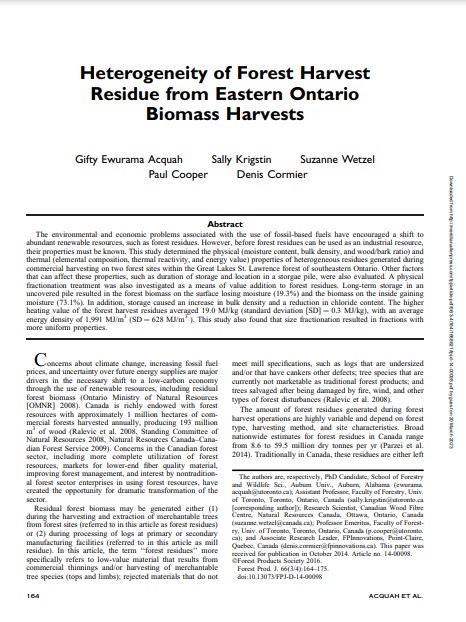Heterogeneity of forest harvest residue from eastern Ontario biomass harvests.
Bosque Modelo:
Eastern Ontario
Temática:
Gestión forestal
Tipo de documento:
Artículo científico
Resumen
The environmental and economic problems associated with the use of fossil-based fuels have encouraged a shift to abundant renewable resources, such as forest residues. However, before forest residues can be used as an industrial resource, their properties must be known. This study determined the physical (moisture content, bulk density, and wood/bark ratio) and thermal (elemental composition, thermal reactivity, and energy value) properties of heterogeneous residues generated during commercial harvesting on two forest sites within the Great Lakes St. Lawrence forest of southeastern Ontario. Other factors that can affect these properties, such as duration of storage and location in a storgae pile, were also evaluated. A physical fractionation treatment was also investigated as a means of value addition to forest residues. Long-term storage in an uncovered pile resulted in the forest biomass on the surface losing moisture (19.3%) and the biomass on the inside gaining moisture (73.1%). In addition, storage caused an increase in bulk density and a reduction in chloride content. The higher heating value of the forest harvest residues averaged 19.0 MJ/kg (standard deviation [SD] ¼ 0.3 MJ/kg), with an average energy density of 1,991 MJ/m3 (SD ¼ 628 MJ/m3 ). This study also found that size fractionation resulted in fractions with more uniform properties.
Información Bibliográfica
Autor:
Acquah, G. E., Krigstin, S., Wetzel, S., Cooper, P., & Cormier, D.
Revista:
Forest Products Journal
Año:
2016
N°:
3
País :
Canadá
Páginas:
164 - 175
Volumen:
66
Idioma:
Ingles
Palabras claves
Model forest, Adaptatation





